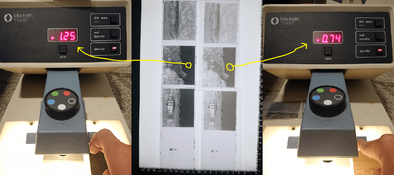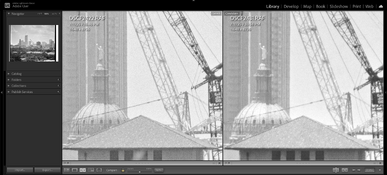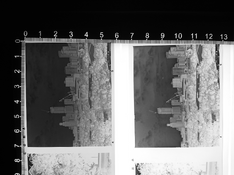For clarity, Photo Systems does not refer you to the old Kodak datasheet for XTol developing times, they refer you to this (frustrating) resource: https://www.digitaltruth.com/devchart.php?Film=&Developer=Xtol%&mdc=Search&TempUnits=C&TimeUnits=D
You are using an out of date browser. It may not display this or other websites correctly.
You should upgrade or use an alternative browser.
You should upgrade or use an alternative browser.
Fresh XTOL from PSI and thin Negatives
-
A
- Thread starter Joerg Bergs
- Start date
Recent Classifieds
-
Want to Buy For parts/broken nikon bodies and lenses
- Started by Gram Nylén
-
For Sale FS: Beseler Printmaker 35 condenser head, Beseler 50mm lens and other parts
- Started by dirkfletcher
-
For Sale FS: (broken) Horseman 6x12 Back
- Started by dirkfletcher
-
For Sale FS: Tamron 150mm f/6.3 Lens
- Started by B.S.Kumar
-
For Sale FS: Royal Soft Focus 150mm f/4.5 Lens
- Started by B.S.Kumar
Forum statistics
@MattKing ..frustrating (and unprofessional) indeed 
As mentioned above, I did contact both PSI and Kodak, the former said that the old data sheets are still valid, the latter told me to take a look at The Massive Devchart.

As mentioned above, I did contact both PSI and Kodak, the former said that the old data sheets are still valid, the latter told me to take a look at The Massive Devchart.
warden
Subscriber
For clarity, Photo Systems does not refer you to the old Kodak datasheet for XTol developing times, they refer you to this (frustrating) resource: https://www.digitaltruth.com/devchart.php?Film=&Developer=Xtol%&mdc=Search&TempUnits=C&TimeUnits=D
Wow. Not great.
@MattKing ..frustrating (and unprofessional) indeed
As mentioned above, I did contact both PSI and Kodak, the former said that the old data sheets are still valid, the latter told me to take a look at The Massive Devchart.
For clarity, both of your contacts above were not to Kodak - either Eastman Kodak or Kodak Alaris.
One was to Photo Systems, and the other was to Photo Systems' Kodak branded chemicals division - where the contact people are their distributors, Cinestill.
Kodak Alaris was the last Kodak direct related entity that had charge of the datasheets, and when they took them over, all they really did was change the name from Eastman Kodak to Kodak Alaris, and delete references to no longer available Kodak films. They weren't involved with the actual manufacture of the chemicals, although they were involved with the scrambling to replace disappearing manufacturing (Tetenal) resources, so they probably helped specify the replacement product specs.
That being said, I expect that Photo Systems has lots of communication with the main film manufacturers - they do make photo chemicals for a fair number of brands, like Eco Pro and Legacy and others.
They just leave it to others to provide user support.
Film-Niko
Member
- Joined
- Jan 22, 2009
- Messages
- 708
- Format
- Multi Format
There are more problems with current Kodak products. Kodak has been switching their 35mm films from triacetate to PET (polyester) carrier (base) since 2018. First the Portra 800, then Gold 200 and now Portra 400 and Ektar are getting thinner and thinner. This causes considerable problems for roll transport machines, as the films are often not transported correctly and get stuck in the machine. There is then a jam and the films are damaged.
My I ask which type of roller transport machines you are using in your lab? Noritsu, Fuji, Agfa or Colenta?
Thinner films are also a problem when adjusting these in a darkroom enlarger.
Hm, I am using 0.1mil. thick PET films in optical printing for decades, and I've not had that problem.
In conducting A/B testing for a book I encountered the following, and was referred to this thread. Known-good HC-110 (left) vs. Fresh Xtol (right). The Xtol was purchased a few months ago, but I don't have the original batch number(s) anymore since it had not occurred to me--in 15 years of using Xtol--that it would ever be a problem.
Both developers were prepared using precision laboratory equipment. All directions were followed precisely.
Scenes were exposed by swapping RB67 backs moments apart, identical settings, and both fresh T-Max 100 rolls were from the same batch. The film was known good.
My original intent was to compare Xtol to Rodinal for an unrelated (resolution) test but after developing the Xtol I was surprised and confused so I sacrificed the second roll into HC-110 as a sanity check.
Both developers were prepared using precision laboratory equipment. All directions were followed precisely.
Scenes were exposed by swapping RB67 backs moments apart, identical settings, and both fresh T-Max 100 rolls were from the same batch. The film was known good.
My original intent was to compare Xtol to Rodinal for an unrelated (resolution) test but after developing the Xtol I was surprised and confused so I sacrificed the second roll into HC-110 as a sanity check.
Attachments
John Wiegerink
Subscriber
Was the Xtol diluted? I wonder if more time would have made a difference. If you are doing everything the same as you always have with Xtol and got this I'd say it's time for you to switch to Adox XT-3. I switched and couldn't be more satisfied. Plus, it's easier to mix than Xtol and you can also buy it in 5L or 1L sizes.In conducting A/B testing for a book I encountered the following, and was referred to this thread. Known-good HC-110 (left) vs. Fresh Xtol (right). The Xtol was purchased a few months ago, but I don't have the original batch number(s) anymore since it had not occurred to me--in 15 years of using Xtol--that it would ever be a problem.
Both developers were prepared using precision laboratory equipment. All directions were followed precisely.
Scenes were exposed by swapping RB67 backs moments apart, identical settings, and both fresh T-Max 100 rolls were from the same batch. The film was known good.
My original intent was to compare Xtol to Rodinal for an unrelated (resolution) test but after developing the Xtol I was surprised and confused so I sacrificed the second roll into HC-110 as a sanity check.
xtol121
Member
Yup. Another example that the supplied times aren’t accurate and that user testing is required to achieve a usable density for darkroom printing. I’ve landed on 13m30s for XTOL 1+1 for 400TX negatives and 12m15s for 320TXP. Both metered at EI 250. But hey, it’s nobody’s fault anymore because nobody knows who’s responsible for accurate data in the data sheet apparently. Just check the massive dev chart  Welcome to the Wild West!
Welcome to the Wild West!
 Welcome to the Wild West!
Welcome to the Wild West!Was the Xtol diluted?
Yes; 1:1 for single-shot, and I do the same with HC-110 (B). But these are precisely how I've always used these two products. Always the same. I have changed nothing, so either the Xtol data sheet is outdated because the product has been reformulated, or there is a quality control issue.
retina_restoration
Member
In conducting A/B testing for a book I encountered the following, and was referred to this thread. Known-good HC-110 (left) vs. Fresh Xtol (right). The Xtol was purchased a few months ago, but I don't have the original batch number(s) anymore since it had not occurred to me--in 15 years of using Xtol--that it would ever be a problem.
Both developers were prepared using precision laboratory equipment. All directions were followed precisely.
Scenes were exposed by swapping RB67 backs moments apart, identical settings, and both fresh T-Max 100 rolls were from the same batch. The film was known good.
My original intent was to compare Xtol to Rodinal for an unrelated (resolution) test but after developing the Xtol I was surprised and confused so I sacrificed the second roll into HC-110 as a sanity check.
I swore off Xtol five or six years ago, back when Sino Promise had made a mess of Kodak chemistry. However, I (reluctantly) bought some of the current Xtol made by Photo Systems Inc. with the hope that they had remedied the problems previously experienced.
For the most part I have been pleased with "Xtol 2025" - it performs as I expected, but with one exception: in all recent work with it when developing both TMY and TMX, I was getting underdeveloped negatives. I adjusted development times by adding 25% more time to the listed times (for Xtol 1:1) and now I am getting good looking negs.
Curiously, this underdevelopment issue was only when Xtol was used with the Tmax films. I did not get thin negs when developing Tri-X, FP4 or Adox CHS 100 II with it. Only Tmax films needed adjusted times.
Since this seemed to be a problem only with TMX and TMY, I suspect something has changed in the formula/manufacture of Xtol that specifically affects these specific products, but I can only speculate.
FWIW.
Curiously, this underdevelopment issue was only when Xtol was used with the Tmax films. I did not get thin negs when developing Tri-X, FP4 or Adox CHS 100 II with it. Only Tmax films needed adjusted times.
I wonder if this can be explained by a pH change or different rate of diffusion due to some other mechanism. It would seem odd, though, and I am not willing to waste more time or money testing Xtol.
Anecdotally, it seemed harder to dissolve this batch of Xtol than normal. I've never had this issue.
Attachments
retina_restoration
Member
I'm curious - what will you use instead? May I recommend PMK perhaps, or maybe home made Mytol (Xtol DIY clone), which I have found very reliable and gives me negatives I expect to see.I wonder if this can be explained by a pH change or different rate of diffusion due to some other mechanism. It would seem odd, though, and I am not willing to waste more time or money testing Xtol.
Yes, I noted that as well. I think I will refrain from buying it - yet again.Anecdotally, it seemed harder to dissolve this batch of Xtol than normal. I've never had this issue.
I'm curious - what will you use instead?
The audience of the book includes high school students and professional non-chemist photographers, so the chemistry must be "available," "easy," and "long-lasting." It wasn't intended to focus on developers, just to show the difference between a solvent vs. non-solvent developer. I chose Xtol because the effect is stronger than with HC-110. But I've written off doing that test now.
Personally I've been using HC-110 the last ~6 years, exclusively for the last few. It is versatile enough for anything I am doing--casually, professionally, or experimentally.
Here is a comparison (Agfa Copex Rapid @ 50, same A/B style exposure) of SPUR Dokuspeed SL-N (left) vs. HC-110 1:240 (right) stand for 1 hour at 23*C, 60s initial ag, 1 inversion every 20 minutes. I made that dilution/recipe up (convenient 10:600mL stock to water for one-shot development). I'm sure it can be further optimized, but density is excellent and comparable to the SPUR developer.
The results are close enough that I wouldn't bother buying SPUR again. (But SPUR does provide a slight edge in resolution, and more importantly better shadow details). Honestly I prefer many of the HC-110 shots. Finer grain. And again it can probably be tuned for better results. This was a first test.
One interesting observation, the SPUR base density is 0.24 while the HC-110 base density is 0.07.
Attachments
Last edited:
runswithsizzers
Subscriber
It's interesting, when I went to the Adox site for their XT-3 chemistry (English version), and click on "PDF Datasheet" it opens the KODAK datasheet for Xtol (J-109, February 2018).Was the Xtol diluted? I wonder if more time would have made a difference. If you are doing everything the same as you always have with Xtol and got this I'd say it's time for you to switch to Adox XT-3. I switched and couldn't be more satisfied. Plus, it's easier to mix than Xtol and you can also buy it in 5L or 1L sizes.
In other words *IF* Adox XT-3 is functionally equivalent to Kodak Xtol, then following the recommendation by Adox to use Kodak's processing time would logically lead to the same end result. Of course Adox XT-3 is not exactly the same as Kodak Xtol, so maybe using XT-3 would lead to a different result(?) I would love to see some side-by-side testing comparing various films, including T-Max 100 and 400, processed in both developers.
retina_restoration
Member
I've been using Adox XT-3 and found it reliable and predictable, but it's rarely available here. I'd be using XT-3 if it were easier to get.
John Wiegerink
Subscriber
All I know is XT-3 works very well for my replenished system and I'm using pretty much my old Xtol times for developing using replenishment. I will admit that when I first started using my new batch of XT-3 it seemed to give me a slightly denser negative than to tail end of the previous batch of Xtol. Now it seems to have mellowed a bit with results that please me at least.It's interesting, when I went to the Adox site for their XT-3 chemistry (English version), and click on "PDF Datasheet" it opens the KODAK datasheet for Xtol (J-109, February 2018).
In other words *IF* Adox XT-3 is functionally equivalent to Kodak Xtol, then following the recommendation by Adox to use Kodak's processing time would logically lead to the same end result. Of course Adox XT-3 is not exactly the same as Kodak Xtol, so maybe using XT-3 would lead to a different result(?) I would love to see some side-by-side testing comparing various films, including T-Max 100 and 400, processed in both developers.
John Wiegerink
Subscriber
Paul,I've been using Adox XT-3 and found it reliable and predictable, but it's rarely available here. I'd be using XT-3 if it were easier to get.
I had a similar problem getting my last couple bottles of FX-39II and XT-3. It was a pretty long wait for it to be "in stock" at Freestyle or Cinestill. I do believe that's a good sign that both will be around for a while since demand for both will keep Adox going.
XTOL alternatives that are functionnaly identical : Adox XT-3, Foma Fomadon Excel, EcoPro B&W film developer.
I believe the third one is more common or maybe even exclusive to the US.
The first two are good, tried, reliable products (never tried EcoPro), not like the mess that are now kodak-branded chemicals ..
I believe the third one is more common or maybe even exclusive to the US.
The first two are good, tried, reliable products (never tried EcoPro), not like the mess that are now kodak-branded chemicals ..
runswithsizzers
Subscriber
XTOL alternatives that are functionnaly identical : Adox XT-3, Foma Fomadon Excel, EcoPro B&W film developer.
I believe the third one is more common or maybe even exclusive to the US.
The first two are good, tried, reliable products (never tried EcoPro), not like the mess that are now kodak-branded chemicals ..
I can't get Lightroom to tell me how many rolls of film I have developed in Legacy Pro Eco-Pro, but it's about 800 shots, divided by some combiniation of 36-exposure 135 and 12-exposure 120. As best as I can recall, I have had no problems with my results from Eco-Pro that were not my own fault.
Based on my experience, Eco-Pro can be added to the list of "good, tried, reliable products."
| Photrio.com contains affiliate links to products. We may receive a commission for purchases made through these links. To read our full affiliate disclosure statement please click Here. |
PHOTRIO PARTNERS EQUALLY FUNDING OUR COMMUNITY:  |













